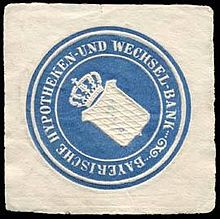Bavarian Mortgage and Exchange Bank
| Bayerische Hypotheken and Wechsel-Bank AG
|
|
|---|---|
| legal form | Corporation |
| founding | 1835 |
| resolution | 1998 |
| Seat |
Munich , Germany |
| Number of employees | approx.15,000 (1998) |
| Branch | Banks |
| Website | hypovereinsbank.de |

The Bayerische Hypotheken und Wechsel-Bank AG was a major bank based in Munich until 1998 with the Bayerische Vereinsbank AG to Bayerische Hypo- und Vereinsbank AG merged.
history
The so-called Hypo-Bank was born when the law “Betr. the establishment of a mortgage and exchange bank ”on July 1, 1834, which the Bavarian state parliament decided on the initiative of King Ludwig I and allowed the formation of a private stock corporation to establish a bank. The share capital was initially 10 million guilders , which was later increased to 20 million. The store opened on October 15, 1835 in the Preysing Palais in Munich. The bank was initially run on a voluntary basis. From the 40 proportionally most significant of the total of 71 shareholders, the so-called bank committee, 7 administrators were selected, all of them Munich business owners (including the Riezler brothers ) who carried out the banking business under the supervision of a state commissioner. Its first director was Baron Simon von Eichthal .
In 1862, the entire capital stock was invested in mortgage loans , which only slowly returned and thus severely restricted the bank's development opportunities with its branches. The introduction of the Pfandbrief in Bavaria subsequently circumvented this obstacle. Before the turn of the century, after the banknote privilege was given up (this was taken over by the Bavarian Central Bank ), it developed from a pure mortgage bank to a universal bank with securities , bills of exchange and current account business . It retained this status until it was dissolved.
From around 1880, the need for space increases with the volume of business, and the bank acquires land near Promenadeplatz . From 1895 to 1898 a new building was built by the architect Emil Schmidt , which housed the company's headquarters until 1998. After the renovation to the Fünf Höfe by Herzog & de Meuron by 2003 , in addition to the newly designed rooms of the bank, a shopping center of the upper category is located on the property.
During the time of National Socialism , the Hypo-Bank was under special observation by the NSDAP because it has traditionally had a large Jewish clientele since it was founded. Insulted by the Nazi propaganda journal Der Stürmer as pro-Jews since 1933, the party repeatedly accused the party of lacking relationships with political authorities. The bank was extremely cautious about the party when it came to requests for donations and memberships. After 1938, the bank had to submit to the laws issued by the Nazi government regarding the treatment of Jewish accounts.
After the Second World War , all regulations related to finding accounts and redress were met. Hypo-Bank was the first bank in Germany to which citizens of the newly founded state of Israel took up business relationships again on their own initiative. In these circles, the bank enjoyed the reputation of having taken a special position during the Nazi era. These customers justified the establishment of the business relationship with the fact that the bank had always kept away from anti-Semitic tendencies.
The art gallery of the Hypo-Kulturstiftung was founded by the bank in 1985 with changing exhibitions and has been continued in Munich to this day. Today's Künstlerhaus Kempten was a banking house of this bank until the 1980s.
Brewery holdings
In the 1970s, Bayerische Hypotheken- und Wechsel-Bank AG acquired major stakes in the brewery industry. By 1979 it had become the largest brewery group in Germany with an annual production volume of around 15 million hectoliters. The bank was the main shareholder in Bamberger Hofbräu AG, Berliner-Schultheiss-Brauerei , Dortmunder Union Brauerei (since 1972), Dortmunder Ritter Brewery , Elbschloss-Brauerei , Erste Kulmbacher Actien-Exportbier-Brauerei, Erich-Bräu (Erlangen), Grüner-Bräu (Fürth), Löwenbräu , Paulaner-Salvator-Thomasbräu-AG , Würzburger Bürgerbräu AG. The brewing holdings were administered from 1972 in the Dortmund Union-Schultheiss Brauerei AG . In 1988 the company changed its name to Brau und Brunnen AG . The investments were also held after the merger with the Bayerische Vereinsbank. In 2004 the bank now known as Hypovereinsbank finally sold the brewing stakes to the Oetker Group .
Web links
- History of the Bayerische Hypotheken- und Wechsel-Bank AG
- Bayerische Hypotheken- und Wechselbank AG . In: Historical Lexicon of Bavaria
- Bayerische Hypotheken- und Wechsel-Bank , logos at trade.mar.cx.
- Early newspaper articles on Bayerische Hypotheken- und Wechsel-Bank in the press kit of the 20th century of the ZBW - Leibniz Information Center for Economics .
Individual evidence
- ↑ http://geschichte.hypovereinsbank.de/de/stammbaum/bayerhypotheken-wechsel-bank.html
- ↑ From a pot in Der Spiegel 30/1979, online at www.spiegel.de , accessed on April 29, 2016
- ↑ Large Schluckverbund in Der Spiegel 20-1972, online at www.spiegel.de , accessed on April 29, 2016
- ↑ Freier Lauf in Der Spiegel 37/1971, online at www.spiegel.de , accessed on April 29, 2016
- ↑ Oetker Group: The Pudding Doctor is Germany's Beer King , at www.spiegel.de , accessed on April 29, 2016

